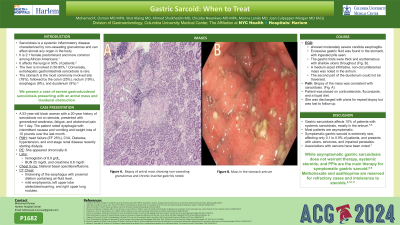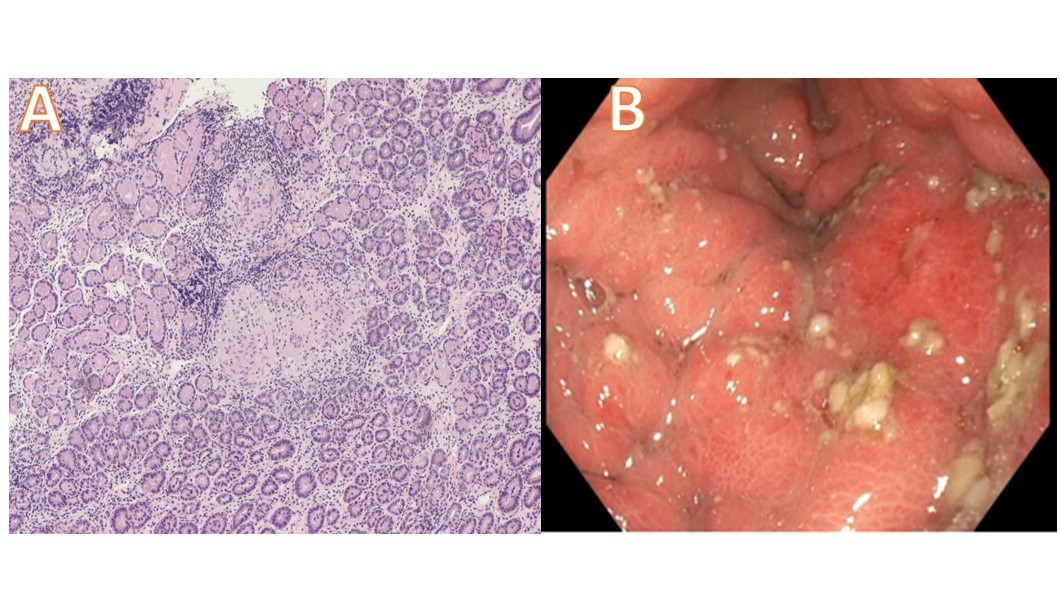Sunday Poster Session
Category: Stomach
P1682 - Gastric Sarcoid: When to Treat
Sunday, October 27, 2024
3:30 PM - 7:00 PM ET
Location: Exhibit Hall E

Has Audio

Mohamed K. Osman, MD, MPH
NYC Health + Hospitals/Harlem
New York, NY
Presenting Author(s)
Mohamed K.. Osman, MD, MPH1, Wut Hlaing, MD2, Ahmed Shaikheldin, MD1, Chizoba Nwankwo, MD, MPA1, Marina Landa, MD1, Joan Culpepper-Morgan, MD, FACG1
1NYC Health + Hospitals/Harlem, New York, NY; 2Harlem Hospital Center, New York, NY
Introduction: Sarcoidosis is a systemic inflammatory disease characterized by non-caseating granulomas and can affect almost any organ in the body. It is 2:1 female predominant and more common among African Americans. It affects the lungs in 90% of patients. The liver is involved in 50-80%. Conversely, extrahepatic gastrointestinal sarcoidosis is rare. The stomach is the most commonly involved site (78%), followed by the colon (25%), rectum (19%), esophagus (9%), and duodenum (9%). We present a case of severe gastroduodenal sarcoidosis presenting with an antral mass and duodenal obstruction.
Case Description/Methods: A 53-year-old black woman with a 20-year history of sarcoidosis not on steroids, presented with generalized weakness, fatigue, and abdominal pain for 1 day. The patient noted dysphagia with intermittent nausea and vomiting and weight loss of 10 pounds over the last month. Her history was notable for heart failure (EF 25%), CVA, Diabetes, hypertension, and end stage renal disease recently starting dialysis. She appeared chronically ill. Labs showed hemoglobin of 8.9 g/dL, BUN 25 mg/dl, and creatinine 6.6 mg/dl. Chest X-ray revealed bilateral basal opacities/effusions. CT chest showed thickening of the esophagus with proximal dilation containing air-fluid level, mild emphysema, left upper lobe atelectasis/scarring, and right upper lung nodules. EGD showed moderately severe candida esophagitis. Excessive gastric fluid was found in the stomach, with ingested pills seen. The gastric folds were thick and erythematous throughout (Figure). A medium-sized infiltrative, non-circumferential mass was noted in the antrum. The second part of the duodenum could not be traversed. Biopsy of the mass was consistent with sarcoidosis. Patient was placed on corticosteroids, fluconazole, and a liquid diet. She was discharged with plans for repeat biopsy but was lost to follow up.
Discussion: Gastric sarcoidosis affects 10% of patients with systemic sarcoidosis, mostly in the antrum. Most patients are asymptomatic. Symptomatic gastric sarcoid is extremely rare, affecting only 0.1 to 0.9% of patients and presents with ulcers, strictures, and impaired peristalsis. Associations with cancers are noted. While asymptomatic gastric sarcoidosis does not warrant therapy, systemic steroids and PPIs are the main therapy for symptomatic gastric sarcoid. Methotrexate and azathioprine are reserved for refractory cases and intolerance to steroids.

Disclosures:
Mohamed K.. Osman, MD, MPH1, Wut Hlaing, MD2, Ahmed Shaikheldin, MD1, Chizoba Nwankwo, MD, MPA1, Marina Landa, MD1, Joan Culpepper-Morgan, MD, FACG1. P1682 - Gastric Sarcoid: When to Treat, ACG 2024 Annual Scientific Meeting Abstracts. Philadelphia, PA: American College of Gastroenterology.
1NYC Health + Hospitals/Harlem, New York, NY; 2Harlem Hospital Center, New York, NY
Introduction: Sarcoidosis is a systemic inflammatory disease characterized by non-caseating granulomas and can affect almost any organ in the body. It is 2:1 female predominant and more common among African Americans. It affects the lungs in 90% of patients. The liver is involved in 50-80%. Conversely, extrahepatic gastrointestinal sarcoidosis is rare. The stomach is the most commonly involved site (78%), followed by the colon (25%), rectum (19%), esophagus (9%), and duodenum (9%). We present a case of severe gastroduodenal sarcoidosis presenting with an antral mass and duodenal obstruction.
Case Description/Methods: A 53-year-old black woman with a 20-year history of sarcoidosis not on steroids, presented with generalized weakness, fatigue, and abdominal pain for 1 day. The patient noted dysphagia with intermittent nausea and vomiting and weight loss of 10 pounds over the last month. Her history was notable for heart failure (EF 25%), CVA, Diabetes, hypertension, and end stage renal disease recently starting dialysis. She appeared chronically ill. Labs showed hemoglobin of 8.9 g/dL, BUN 25 mg/dl, and creatinine 6.6 mg/dl. Chest X-ray revealed bilateral basal opacities/effusions. CT chest showed thickening of the esophagus with proximal dilation containing air-fluid level, mild emphysema, left upper lobe atelectasis/scarring, and right upper lung nodules. EGD showed moderately severe candida esophagitis. Excessive gastric fluid was found in the stomach, with ingested pills seen. The gastric folds were thick and erythematous throughout (Figure). A medium-sized infiltrative, non-circumferential mass was noted in the antrum. The second part of the duodenum could not be traversed. Biopsy of the mass was consistent with sarcoidosis. Patient was placed on corticosteroids, fluconazole, and a liquid diet. She was discharged with plans for repeat biopsy but was lost to follow up.
Discussion: Gastric sarcoidosis affects 10% of patients with systemic sarcoidosis, mostly in the antrum. Most patients are asymptomatic. Symptomatic gastric sarcoid is extremely rare, affecting only 0.1 to 0.9% of patients and presents with ulcers, strictures, and impaired peristalsis. Associations with cancers are noted. While asymptomatic gastric sarcoidosis does not warrant therapy, systemic steroids and PPIs are the main therapy for symptomatic gastric sarcoid. Methotrexate and azathioprine are reserved for refractory cases and intolerance to steroids.

Figure: A: Biopsy of antral mass showing non-caseating granulomas and chronic inactive gastritis noted. B: Mass in the stomach antrum
Disclosures:
Mohamed Osman indicated no relevant financial relationships.
Wut Hlaing indicated no relevant financial relationships.
Ahmed Shaikheldin indicated no relevant financial relationships.
Chizoba Nwankwo indicated no relevant financial relationships.
Marina Landa indicated no relevant financial relationships.
Joan Culpepper-Morgan indicated no relevant financial relationships.
Mohamed K.. Osman, MD, MPH1, Wut Hlaing, MD2, Ahmed Shaikheldin, MD1, Chizoba Nwankwo, MD, MPA1, Marina Landa, MD1, Joan Culpepper-Morgan, MD, FACG1. P1682 - Gastric Sarcoid: When to Treat, ACG 2024 Annual Scientific Meeting Abstracts. Philadelphia, PA: American College of Gastroenterology.
